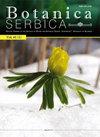Phytochemical analysis, antioxidant and antimicrobial activities of Salvia virgata mericarps
IF 1.1
4区 生物学
Q4 PLANT SCIENCES
引用次数: 3
Abstract
The phytochemical contents of Salvia virgata mericarps and the antioxidant and antimicrobial activities of its ethanol extract were studied for the first time. S. virgata mericarps were collected in the province of Trabzon, Turkey. Chemical analyses were performed using chromatographic methods. The total phenolic and flavonoid contents and antioxidant potential were measured using Folin-Ciocalteu, Al(NO3)3, and DPPH radical scavenging activity methods, respectively. The antimicrobial activity was evaluated using the microdilution method for all the tested bacterial and fungal strains, with the exception of Mycobacterium tuberculosis for which the resazurin microtiter plate method was applied. The mericarps were rich in glutamic acid (3934 mg/100 g), potassium (12578.8 ?g/g), calcium (12092.0 ?g/g), and dietary fibers (35.565 g/100 g). The total phenolic and flavonoid contents were 2.50 ?g GAE/mg extract and 0.34 ?g QE/mg extract, respectively. The most effective DPPH free radical scavenging activity determined for the highest applied concentration was 92.44%. The ethanol extract obtained from the mericarps was found to be as effective as the reference drug ampicillin (MIC value = 125 ?g/mL) against the nosocomial pathogen Acinetobacter baumannii. In conclusion, S. virgata mericarps provide good nutritional value with low amounts of carbohydrates and high dietary fibers, amino acids, minerals and total phenolic and flavonoid contents and medicinal properties.分叶鼠尾草的植物化学分析及抗氧化和抗菌活性
首次研究了分角鼠尾草的植物化学成分及其乙醇提取物的抗氧化和抑菌活性。在土耳其的特拉布宗省采集了维加塔美卡普。采用色谱法进行化学分析。采用Folin-Ciocalteu法、Al(NO3)3法和DPPH自由基清除法分别测定其总酚和类黄酮含量及抗氧化能力。采用微量稀释法对所有被试细菌和真菌菌株进行抑菌活性评估,但结核分枝杆菌采用瑞祖林微滴板法。分果富含谷氨酸(3934 mg/100 g)、钾(12578.8 g/g)、钙(12092.0 g/g)和膳食纤维(35.565 g/100 g),总酚和类黄酮含量分别为2.50 g GAE/mg和0.34 g QE/mg。在最高浓度下,对DPPH自由基的清除能力为92.44%。结果表明,该提取物与参比药氨苄西林(MIC值为125 μ g/mL)对院内病原菌鲍曼不动杆菌的抑菌效果相当。综上所述,分角荆芥碳水化合物含量低,膳食纤维、氨基酸、矿物质、总酚和类黄酮含量高,具有良好的营养价值和药用价值。
本文章由计算机程序翻译,如有差异,请以英文原文为准。
求助全文
约1分钟内获得全文
求助全文
来源期刊

Botanica Serbica
Agricultural and Biological Sciences-Plant Science
CiteScore
1.40
自引率
12.50%
发文量
17
审稿时长
34 weeks
期刊介绍:
Botanica Serbica publishes original research papers on all aspects of plant, fungal and microbial biology research including the disciplines of microbiology, mycology, lichenology, bryology, flora, vegetation, biogeography, systematics, taxonomy, plant biotechnology, plant cell biology, plant ecology, environmental plant biology, forestry, genomics, horticulture, limnology, metabolomics, molecular biology, proteomics, virology, plant conservation and protection, and wildlife and ecosystem management.
 求助内容:
求助内容: 应助结果提醒方式:
应助结果提醒方式:


